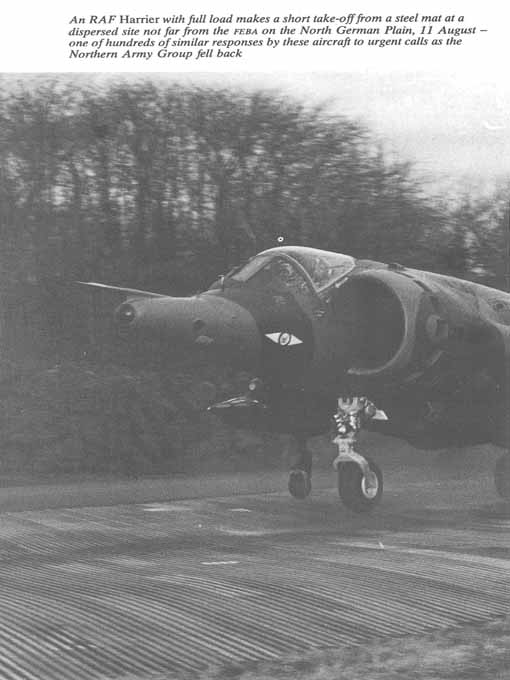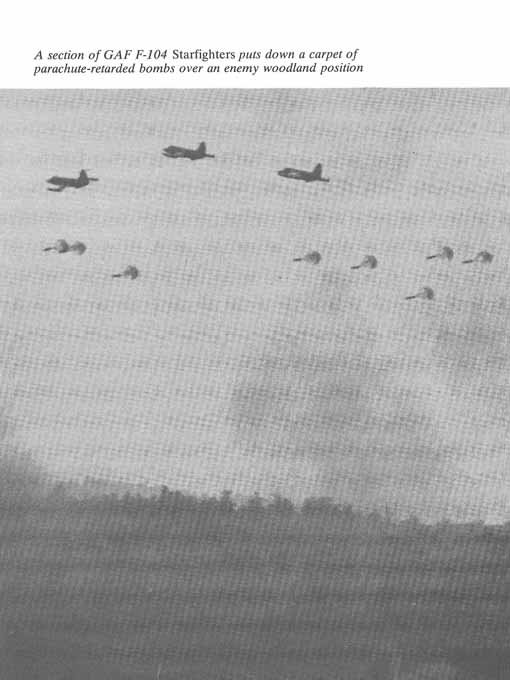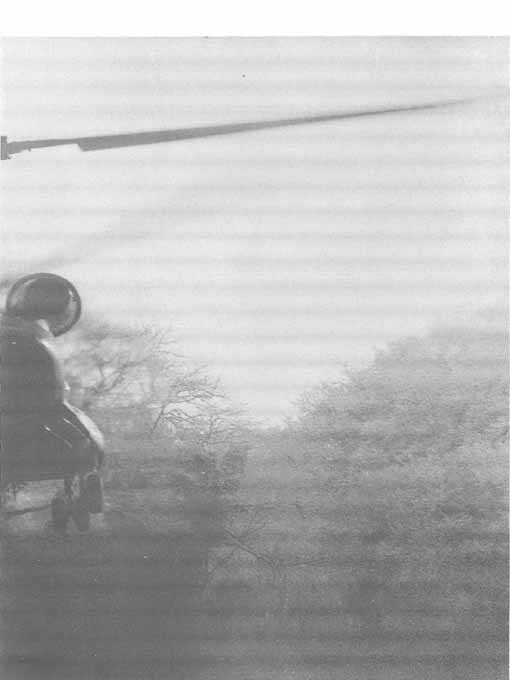The Third World War - The Untold Story (12 page)
Read The Third World War - The Untold Story Online
Authors: Sir John Hackett
Tags: #Alternative History



The Anglo/German/Italian multi-role combat aircraft (MRCA) brought into service as the
Tornado
in its specialized long-range interceptor role in the UK, and its interdiction and counter-air role for the European continent, was a very recent and promising arrival. The German Air Force (GAF) was tied by political and geographical logic to the defence of its own air space, direct support of the land forces of CENTAG (Central Army Group) and NORTHAG, and interdiction and counter-air operations over enemy territory. By 1984 the GAF had received most of its
Tornados
and its air defence force was made up of F-4
Phantoms
and a residue of F-104
Starfighters
left over from the 1960s.
Each of the Allied air forces was backed up in some degree by air transport and helicopters. The helicopter was an unknown factor in operations on the scale and at the intensity that were to be experienced in the Third World War. In the event it played a versatile and often indispensable part in many roles, and notably so with the Warsaw Pact forces. But as had always been expected, losses were high and it remains an open question as to how long the helicopters could have remained on the battlefield in a longer war. The United States Army and Air Force, with Vietnam experience behind them, were to use large numbers in the gunship and logistic roles, with great skill and often with decisive local effect. In the first days of the war German and British helicopters were virtually to save the re-supply situation in NORTHAG’s rear area. The threat to soft-skinned vehicles from SAF armed reconnaissance aircraft had been seriously underestimated and the roads were blocked with wrecked trucks as well as civilian refugees. To compound the chaos and confusion the FEBA was falling steadily back to the west and it was chiefly through a non-stop shuttle of medium-lift helicopters that the ammunition and fuel would reach the front.

In a more offensive mode RAF
Puma
helicopters were to be used to move army anti-tank teams and their
Milan
weapons across the axes of the enemy’s advance to new positions as his thrust lines swung. When they achieved surprise and found good firing positions this proved an excellent way of keeping the anti-tank weapons in action against the enemy. The British Army’s
Lynxes
were effectively used in a similar way. But the British had always been hesitant about helicopters, partly because of their vulnerability, and partly because of their cost. By 1985 the British Army and the RAF had still to agree upon whether the helicopter should be regarded as an air or ground system. In consequence the capabilities of this remarkable, but admittedly vulnerable, machine were not always fully exploited in the battle in the north.


This was not true of the Soviet forces, which had always loved helicopters and built models for every kind of task and weapon. They were to use them as self-propelled guns flying above and ahead of their leading armour, as anti-tank platforms and as electronic counter-measure (ECM) stations. They even armed some with air-to-air weapons. Not surprisingly they fell easily and in large numbers to the US
Patriot
missiles (which were coming into service but were not yet plentiful) and the British
Rapier
and French
Rolands
and
Sicas
deployed by the NATO armies. Nevertheless, Allied ground force commanders at all levels would have cause to reflect that the need to strengthen their defences against marauding helicopters had not been fully appreciated.
Bringing offensive air support to bear on the enemy’s vulnerable articulation points in a fast-moving battle places a high premium on tactical air reconnaissance, with its rapid reporting and subsequent response. This was done in the main by interdictor or fighter aircraft operating with specialized crews and equipment. Over the sea, maritime aircraft patrolled against submarines and surface ships, with land-based helicopters working closer inshore. The whole Western European theatre was enclosed by the NATO air defence ground environment (NADGE), a radar warning system within which, in addition to the air fighters, there were arrays of ground-based surface-to-air missiles (SAM) for point and area defence. In the event the demand for air reconnaissance far exceeded the limited numbers of aircraft and crews available to carry it out. Whether there should have been more tactical reconnaissance squadrons must remain a moot point. More here would have meant less somewhere else. To give an idea of scale, it is worth noting that the USAF possessed approximately five times the number of aircraft of the whole of the RAF and GAF together.
On the broader front of intelligence - and that was very broad indeed - it had always been feared by the sceptics that in a major war the Allied intelligence system with its computerized ‘fusion centres’ would get clogged up - and it did. The input from satellites, airborne radars, electronic sensors, photography, and a host of other sources was vast and although the computers swallowed it all at great speed and spat it out again obligingly enough, they did so in an uncomprehending way. When war broke out intelligence centres had to be diluted with inexperienced or out-of-practice staffs and this was to hinder the speed at which the significance of bald data could be appreciated - as for example after the Gdansk incident, described at the end of this chapter, when the crucial information about the Soviet Air Force
Cooker
frequencies took forty-eight hours to reach the operating units that so desperately needed it. But the learning curve is steep in war and processing and evaluating times were to be greatly reduced in the first few days. Nevertheless, the human burden in handling the nearly overwhelming volume of data that the sensors, computers and communications could collect, store and deliver was tremendous and was to remain so throughout the war.

The British and German air force commanders had long seen that they would need an agile air-superiority fighter to replace their
Phantoms
in the 1980s, in order to counter the growing tactical air power that the Warsaw Pact would be able to bring to bear over a land battle in the Central Region. For political reasons this had to be tackled as a multi-national collaborative project and joint studies were started by the UK and the FRG with the French, who had a similar need. This well-intentioned collaboration got nowhere and the project was dropped. Differences in specifications and timescales could not be reconciled and the costs of the
Tornado
, which were getting badly out of control, squeezed out what little room was left in the forward defence budgets of the Federal Republic and the UK. The French kept their thoughts and their plans to themselves as the British and German staffs accepted that they would have to make do with their
Phantoms
for the rest of the decade. This was unfortunate but for the British there was at least the consolation that there was now room for a handsome increase of some eighty aircraft in the
Harrier
force. This would be welcome in the land battle but one result would be that Britain and Germany, if forced into a war in the 1980s, would be using fighter aircraft that were more than twenty years old in concept and design - the
Tornado
excepted - and that they would have no contemporary air-superiority fighter for the air battle.
The smaller northern NATO countries had managed their admittedly simpler resource problems rather better by plumping for the US F-16
Fighting Falcon
tactical fighter in the mid-seventies. Although ‘buying American’ when there was so much drive behind the idea of developing the European aerospace industry had been a controversial decision, the war was to show that the Norwegian, Belgian, Dutch, and Danish air forces had made a sound and timely choice. Although the separate national air force orders were not large, the aggregate of more than 200 F-16
Fighting Falcon
fighters, some with an enhanced night and bad-weather capability, together with the new
Mirage
2000 of the French Air Force, did much to redress the RAF and GAF deficiencies in this area.
The French Air Force could not of course be included in the NATO order of battle - nor in any formal NATO plans or calculations. But its air defence was tied in with NADGE and military liaison with NATO was close. Although France had an interest in a new tactical fighter its need was not as pressing as that of Germany and Britain. The French Air Force had a satisfactory and well-assured programme for the early 1980s of replacing its earlier
Mirage
interceptors with the
Mirage
2000 in both the tactical and interceptor roles. The interdiction and tactical attack roles were covered by the Anglo-French
Jaguar.
The French Air Force, with ample opportunities for dispersal and the advantage of operating on internal lines of communication, looked, and turned out to be, an effective, well balanced and modern force.
